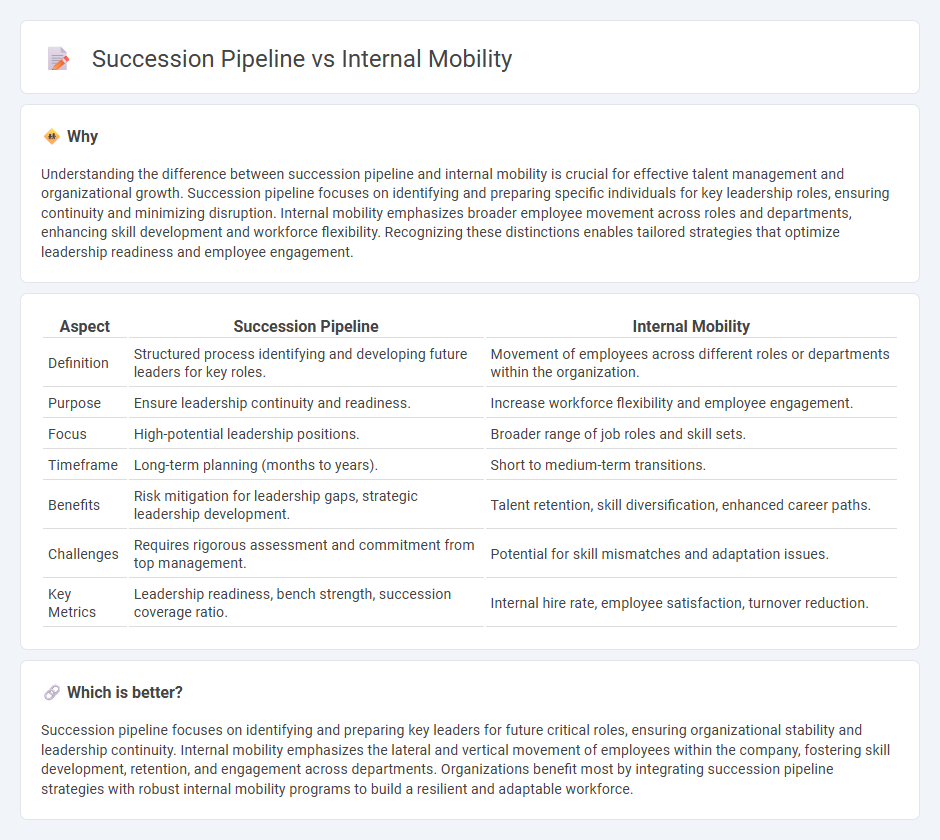
Succession pipeline focuses on preparing specific employees for critical leadership roles through targeted development and strategic planning, ensuring organizational continuity and stability. Internal mobility emphasizes broader opportunities for employees to advance or transition within different departments, fostering talent retention and skill diversification. Explore how aligning succession pipeline and internal mobility strategies can optimize workforce agility and leadership readiness.
Why it is important
Understanding the difference between succession pipeline and internal mobility is crucial for effective talent management and organizational growth. Succession pipeline focuses on identifying and preparing specific individuals for key leadership roles, ensuring continuity and minimizing disruption. Internal mobility emphasizes broader employee movement across roles and departments, enhancing skill development and workforce flexibility. Recognizing these distinctions enables tailored strategies that optimize leadership readiness and employee engagement.
Comparison Table
| Aspect | Succession Pipeline | Internal Mobility |
|---|---|---|
| Definition | Structured process identifying and developing future leaders for key roles. | Movement of employees across different roles or departments within the organization. |
| Purpose | Ensure leadership continuity and readiness. | Increase workforce flexibility and employee engagement. |
| Focus | High-potential leadership positions. | Broader range of job roles and skill sets. |
| Timeframe | Long-term planning (months to years). | Short to medium-term transitions. |
| Benefits | Risk mitigation for leadership gaps, strategic leadership development. | Talent retention, skill diversification, enhanced career paths. |
| Challenges | Requires rigorous assessment and commitment from top management. | Potential for skill mismatches and adaptation issues. |
| Key Metrics | Leadership readiness, bench strength, succession coverage ratio. | Internal hire rate, employee satisfaction, turnover reduction. |
Which is better?
Succession pipeline focuses on identifying and preparing key leaders for future critical roles, ensuring organizational stability and leadership continuity. Internal mobility emphasizes the lateral and vertical movement of employees within the company, fostering skill development, retention, and engagement across departments. Organizations benefit most by integrating succession pipeline strategies with robust internal mobility programs to build a resilient and adaptable workforce.
Connection
Succession pipeline and internal mobility are interconnected through their focus on talent development and organizational resilience. A robust succession pipeline relies on internal mobility to identify and prepare employees for critical leadership roles, ensuring a seamless transition and continuity of business operations. Promoting internal mobility accelerates skill acquisition and experience, which strengthens the succession pipeline by creating a pool of qualified candidates ready to assume future positions.
Key Terms
Talent Development
Internal mobility accelerates talent development by enabling employees to acquire diverse skills and experiences through lateral moves and promotions within the organization. Succession pipelines strategically prepare high-potential employees for critical leadership roles, ensuring business continuity and leadership readiness. Explore how integrating internal mobility with succession planning enhances workforce agility and optimizes talent development strategies.
Career Pathing
Internal mobility enhances career pathing by enabling employees to transition between roles within the organization, fostering growth and retention. Succession pipeline focuses on identifying and developing key talent to fill critical leadership positions, ensuring organizational continuity. Explore how aligning these strategies can optimize workforce development and drive business success.
Leadership Readiness
Internal mobility enhances leadership readiness by enabling organizations to identify and develop high-potential employees for critical roles, fostering a dynamic and adaptable workforce. Succession pipelines offer a structured approach to preparing future leaders through targeted training and mentorship, ensuring seamless transitions in leadership positions. Explore how integrating internal mobility with succession planning can maximize leadership effectiveness and organizational resilience.
Source and External Links
Internal Mobility: What Is It and Why Do You Need It? - This article explains internal mobility as the movement of employees within a company for career development and outlines steps to encourage it.
The 2025 Guide: 10 Ways to Boost Internal Mobilty - This guide provides strategies to enhance internal mobility by implementing transparent policies, leveraging technology, and fostering a supportive culture.
What is Internal Mobility and Why is it Important? - This article discusses internal mobility as a means to enhance employee careers and retain talent by utilizing internal recruitment strategies.
 dowidth.com
dowidth.com